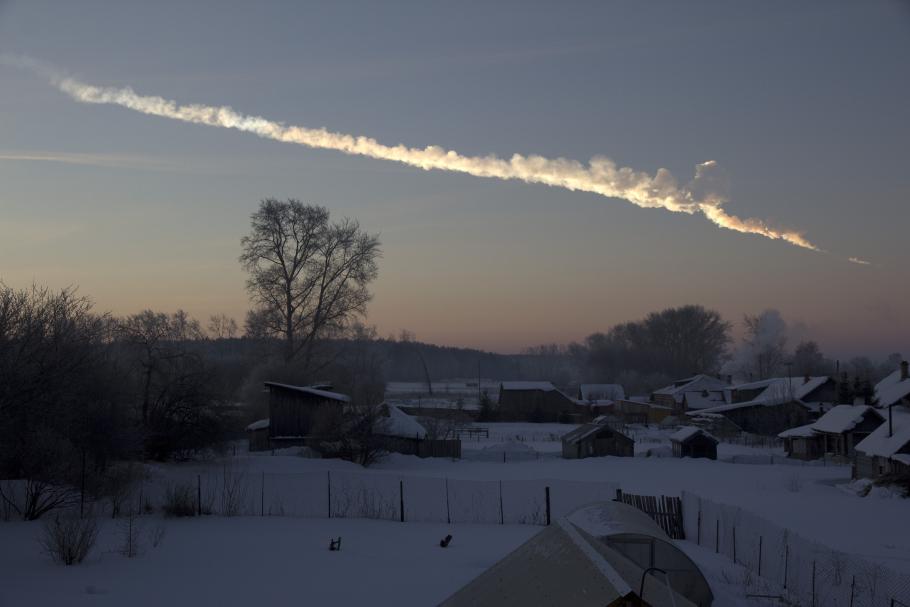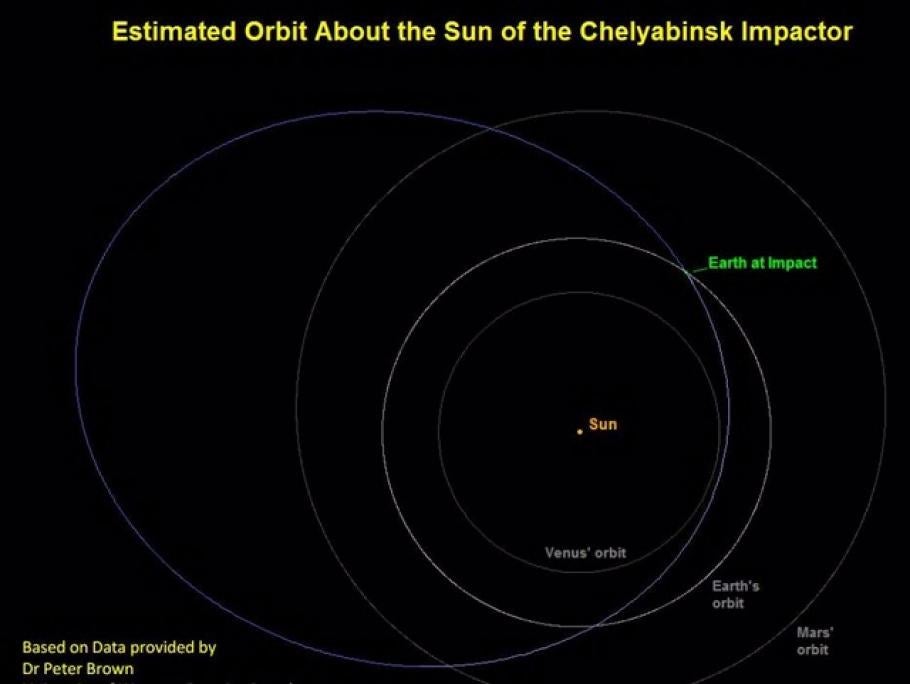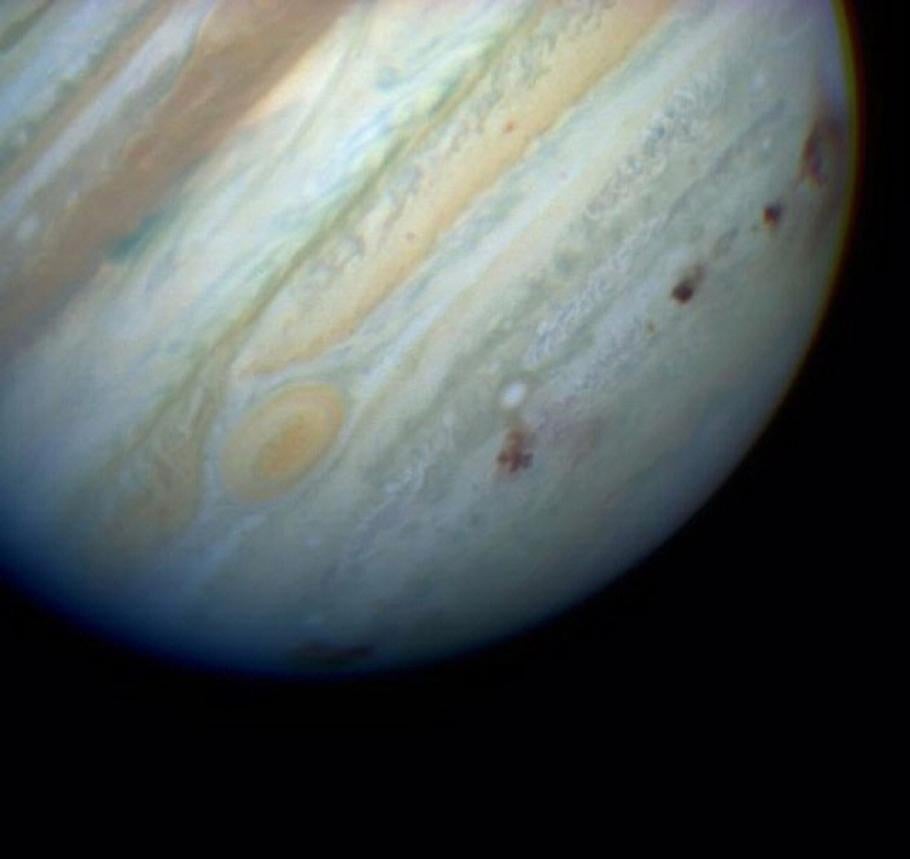Yes, the sky is falling. The asteroid impact that took place in Chelyabinsk, Russia, on February 15, 2013, has jump-started an international conversation about planetary protection and whether or not there is a really big asteroid/meteor/comet out there with our name on it. There is, we just haven’t found it yet.
This image of a vapor trail was captured about 125 miles (200 kilometers) from the Chelyabinsk meteor event, about one minute after the house-sized asteroid entered Earth’s atmosphere.
Miniscule objects enter the atmosphere all the time; occasionally larger objects come down—the Tunguska (1908) and Chelyabinsk (2013) events are prime examples of this—and once in a very great while a mass extinction impact takes place as in the Cretaceous–Paleogene extinction event of 66-65 million years ago that wiped out the dinosaurs.
I first heard a scientist talk about this in 1992 when he explained that several thousand interplanetary objects were on collision courses with Earth, and that several small pieces entered the atmosphere every day. It is only a matter of time before a really large one hit the Earth, and the results could be catastrophic. The scientist urged the cataloging of all possible Earth-crossing asteroids, the tracking of their trajectories, and the beginning of research and development on countermeasures to deal with those objects heading for Earth.
Most of the audience departed this speech with mixed feelings, recognizing the reality of what had been said and also denying that it bore any relationship to reality. Indeed, while the scientific theory that a great galactic meteor slamming into the Earth had created a form of “nuclear winter” that made the dinosaurs extinct was gaining currency at the time, few believed a real threat existed in the present. After all, at that time the United States had just achieved the most impressive triumph of its history, defeat of the Soviet Union in the Cold War and stood essentially omnipotent in the world as a superpower.
Now another threat is before us: this time it’s from space and there is currently no technology to defeat it. Now with the Chelyabinsk event as a modern object lesson, there is reason to take seriously the need to mitigate asteroid, comet, or meteor impacts in the future. A major divergence of opinion concerns how the United States should respond to this threat of impact. Most scientists conclude that there is a significant risk and that governments should take some action (especially in searching for Earth-crossing asteroids), but that it is premature to expend enormous amounts of funds for defense systems in the absence of a specifically identified threat. Military leaders argue strongly for a more aggressive approach to asteroid defense. Many assert that the United States must start immediately to develop technology to deflect an object heading for Earth.
This policy debate makes for excellent news stories, and reporting has tended to state the extremes rather than the middle ground that actually dominates. What is taking place is actually quite appropriate for the level of the potential threat to the planet. Efforts are underway to catalog all potentially threatening objects and to strategize on how to prevent cosmic-induced chaos through such means as evacuation or the use of weapons of mass destruction to shift an incoming object’s path away from Earth.
Could viable options be developed to mitigate any threat were it detected years or even decades ahead of time? With that much advance notice, we might be able to reach an asteroid with a robot that could nudge it enough to cause it to miss Earth. Changing the asteroid’s speed by only a small fraction of one mile per hour would be sufficient if action were taken early enough. Some proposed schemes include:
- Crash a rocket into one side of the asteroid to deflect its course. This plan would be most feasible for asteroids less than about 300 feet wide.
- Explode a neutron bomb in space at some distance from the asteroid. The explosion would almost instantly heat one side of the asteroid, causing chips of rock to explode away. By the principle of action and reaction, the asteroid would begin to drift slowly in the opposite direction.
- Land some kind of rocket engine on the surface of the asteroid and operate the engine for several years, pushing the asteroid gently into a new orbit.
Rapid advances in technology in the coming decades may reveal other, better methods that cannot be foreseen for dealing with these possibly threatening objects. Can human efforts prevent catastrophe from a large asteroid or comet? The answer is yes, if it is detected sufficiently early. A rocket full of (probably nuclear) explosives would have to be launched. One would not try to destroy the object since this would cause it to fragment into pieces leading to an equally destructive “multiple warhead,” much like the case of comet Shoemaker-Levy 9 that blasted Jupiter in 1994. Instead, the explosion would need to take place next to the object. This would create a small change in its direction of motion, causing a significant deviation in its orbit over time and distance.
With current technologies, an Earth-striking asteroid or comet would have to be detected years, perhaps decades, in advance for preventative measures to be effective. The lead time is determined by the size of the object and its trajectory. It is yet to be determined if the technology is sufficient to meet this very real possibility. Concerning this, the late Congressman George Brown stated in 1993: “If some day in the future we discover well in advance that an asteroid that is big enough to cause a mass extinction is going to hit the Earth, and then we alter the course of that asteroid so that it does not hit us, it will be one of the most important accomplishments in all of human history.”
Of course, there is another answer. If we find something coming toward us, we could round up a bunch of oil riggers from the Gulf, put them under the command of Bruce Willis, fly a space shuttle up to rendezvous with the object, plant bombs on it, and blow it up. After all a blockbuster feature film, Armageddon, was based on this premise. For so many reasons this scenario is not an option. It is actually a ridiculous storyline. It is not ridiculous, however, to undertake appropriate steps to mitigate this interplanetary threat. Increasing funding for research and development toward the deployment of countermeasures, as well as all sky surveys to find and track near Earth objects, is an appropriate response.



